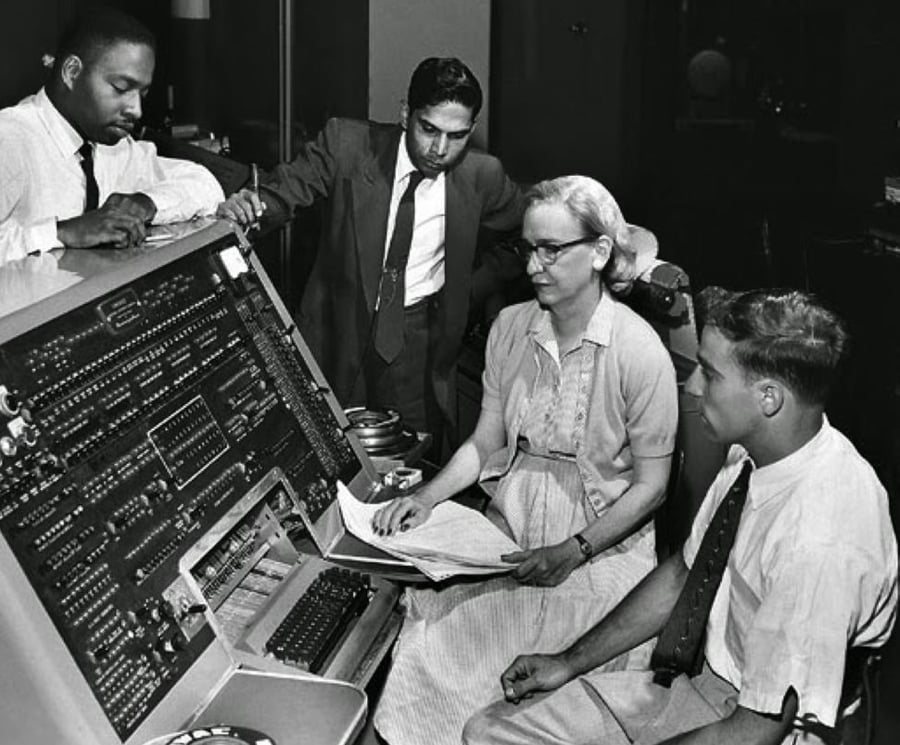
Aiken's team used the two computers side by side, effectively achieving an early instance of multiprocessing.īy the end of the war, Hopper had become enamored of Navy life, but her age -a mere forty years-precluded a transfer from the WAVES into the regular Navy. By this time, the Mark II had been built.
#Grace hopper free
To reduce the number of programming errors, Hopper and her colleagues collected programs that were free of error and generated a catalogue of subroutines that could be used to develop new programs.
#Grace hopper code
The exacting code of machine language could be easily misread or incorrectly written. Thus, Hopper experienced firsthand the complexities and frustration that have always been the hallmark of the programming field.

The Mark I was the first digital computer to be programmed sequentially. With the help of two ensigns assigned to the project and a sudden plunge into the works of computer pioneer Charles Babbage, Hopper began a crash course on the current state of computation by way of what Aiken called "a computing engine." Without any background in computing, she was handed a code book and asked to begin computations. In other words, Aiken was in the process of building and programming America's first programmable digital computer-the Mark I.įor Hopper, the experience was both disconcerting and instructive. Project, directed by Howard Aiken, was her first introduction to Aiken's task, which was to devise a machine that would assist the Navy in making rapid, difficult computations for such projects as laying a mine field. She was immediately assigned to the Bureau of Ships Computation Project at Harvard. Naval Reserve, attending midshipman's school and obtaining a commission as a lieutenant in 1944. They were divorced in 1945 and had no children. She lived with her husband, Vincent Foster Hopper, whom she had married in 1930. Hopper taught at Vassar until the beginning of World War II. Despite bleak prospects for female mathematicians in teaching beyond the high school level, Vassar College hired her first as an instructor, then as a professor of mathematics. doctorates in mathematics numbered only 1, 279 between 18. As Robert Slater points out in Portraits in Silicon, U.S. These were rare achievements, especially for a woman. She graduated in 1928, then attended Yale, where she received a master's degree in 1930 and a doctorate in 1934. Her grandfather had been a senior civil engineer for New York City who inspired her strong interest in geometry and mathematics.Īt Vassar College, Hopper indulged her mathematical interests, and also took courses in physics and engineering.

Encouraged by her parents to develop her natural mechanical abilities, she disassembled and examined gadgets around the home, and she excelled at mathematics in school.

She was the first child of Marry Campbell Van Horne Murray and Walter Fletcher Murray. In 1991, President George Bush presented her with the National Medal of Technology "for her pioneering accomplishments" in the field of data processing.Īdmiral Hopper was born Grace Brewster Murray on December 9, 1906, in New York City. She was an influential force and a legendary figure in the development of programming languages.

#Grace hopper software
Her professional life spanned the growth of modern computer science, from her work as a young Navy lieutenant programming an early calculating machine to her creation of sophisticated software for microcomputers. Grace Hopper, who rose through Navy ranks to become a rear admiral at age eighty-two, is best known for her contribution to the design and development of the COBOL programming language for business applications. With the longest active military career, Rear Admiral Grace Hopper (1906-1992) was also known as "Amazing Grace" and "Grand Old Lady of Software." She played an instrumental role in the development of the COBOL computer programming language.


 0 kommentar(er)
0 kommentar(er)
